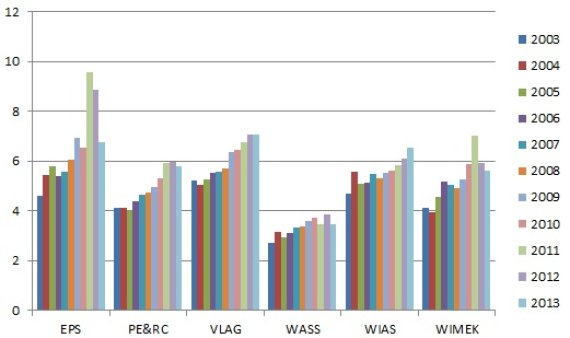This can be seen from an overview of the output of the six graduate schools from 2003 to 2013. The schools, and therefore the graduate students too, do most of the scientific research at the university. ‘The PhD candidates are the worker bees of Wageningen University,’ states Wouter Gerritsma, an information specialist at the Forum library, ‘They are responsible for 70 percent of the peer-reviewed papers from the university.’ The number of publications has also risen sharply, independently of the number of co-authors. The graduate schools published almost twice as many papers in 2013 as ten years earlier. Gerritsma believes that the increase in the number of co-authors reflects the fact that science is increasingly becoming a team sport. ‘Research has become more and more complex; increasing numbers of people are involved. You can no longer do research on your own. International cooperation is in fact encouraged. That scores better and you always have to have partners to get funding.’
Research has become more and more complex (…), you can no longer do research on your own
Wouter Gerritsma
Gerritsma sees a conflict here. ‘PhD students are judged on their individual performance. But that contradicts what is actually demanded of them in practice, where it’s all about cooperation and networking. You can see that reflected in the publication culture.’
Tenure track is identified as one possible cause. The pressure that a tenure track puts on scientists to publish could be encouraging the misuse of co-authorship. That is not what the figures show, though, according to Gerritsma. ‘I’ve heard that explanation often enough. A tenure tracker needs a certain number of publications – points – per year. That does make it handy for people to list each other as co-authors. But tenure tracks were introduced in 2009 and the increase in the number of co-authors started much earlier than that.’
The VLAG graduate school (nutrition and food technology) scores highest with an average of seven authors per article, followed by EPS (plants). In 2011, EPS had a peak of more than nine authors per article. Gerritsma says, ‘That outlier is because of an article published in Nature giving the complete a genome of the tomato. That article had 322 authors.’ Social sciences are traditionally where publications have the fewest co-authors. But the publication culture is changing there too and an upward trend can be seen. ‘Social scientists are publishing less and less in books and more and more in articles. You can see that reflected in the number of articles as well: four times as many as ten years ago.’

